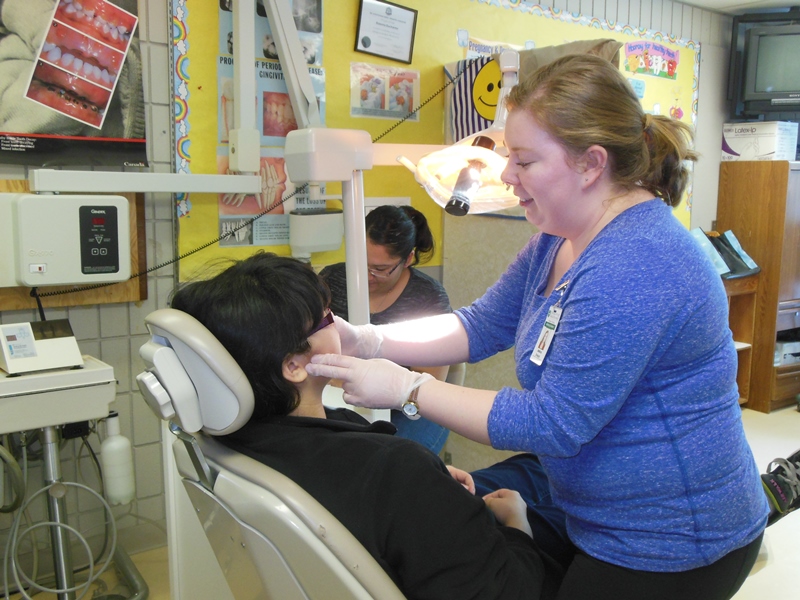Interprofessional Education
Program
The Bachelor of Science in Nursing program/curriculum is the anchor for interprofessional education (IPE) throughout the continuum from policy, theory, to practice, focusing on outcomes that come from innovative learning strategies and strategies grounded in evidence.
Interprofessional Education Pathway
The Interprofessional Education Pathway diagram was created to outline the specific courses in the undergraduate program that include IPE activities. These activities are highlighted in red.
Initiatives

The underlying principle of the Rural Partnership project is to work with communities to develop and implement sustainable IPE initiatives that meet both the needs of the educational programs and the community. The pilot study of the project took place in Humboldt, Saskatchewan and was funded jointly through a grant from the Saskatchewan Academic Health Sciences Network and the Council of Health Sciences Deans at the University of Saskatchewan. To date (August, 2016), 75 students from Medicine, Nursing, Pharmacy, Nutrition and Physical Therapy have participated in the project. Read more.

Third year nursing students from La Ronge and Ile-a-La Crosse completed their pediatric practicums in four schools in 2014, the first ever pediatric clinical rotation to take place in a northern school. By the end of their practicum experience, the nursing students conducted assessments and used their pediatric knowledge base to organize numerous activities, including health education, physical activities, wellness assessments and health screening, referrals to other healthcare professionals as necessary and oral health screening and treatment. Read more.
Educational Supports
The following section offers strategies to support faculty, staff, students and individuals to acquire knowledge and skills related to interprofessional education. There are numerous supports available; the resources provided are general and it is encouraged to continually engage in exploring new literature and evidence for IPE and collaborative practice.
This video provides basic information related to IPE and collaborative practice. The content focuses on the Canadian Interprofessional Health Collaborative ([CIHC], 2010) framework and provides examples of each competency.
The Center for Interprofessional Education at the University of Toronto has developed a series of videos that highlight various aspects of interprofessional education and collaborative practice. These resources can be used in a variety of settings, such as classroom or practice forums.
These videos can be accessed in person through the University of Saskatchewan Library:
- DVD 1: Student Experiences in Interprofessional Education.
- DVD 2: DVD & CD Set 2: Collaboration in Primary Care: A Professional Development Multi-Media Toolkit
- DVD 3: Interprofessional Education and Collaboration in Primary Care
- DVD 4: Carole Laurin: Reflections on Interprofessional Care.
- DVD 5: Don't These People Talk to Each Other?
- DVD 6: Facilitating Interprofessional Collaboration with Students
The College of Nursing and the Health Sciences Colleges at the University of Saskatchewan have adopted the six interprofessional competencies identified in the National Interprofessional Competency Framework:
- Role Clarification
- Team Functioning
- Patient/Client/Family Community-Centered Care
- Collaborative Leadership
- Interprofessional Communication
- Interprofessional Conflict Resolution
The University of British Columbia has created six competency-based modules designed to support interprofessional education for interprofessional collaborative practice. The modules can be used by educators or facilitators to introduce participants to the competency domains identified in the National Interprofessional Competency Framework. The modules are self-directed and approximately 30 minutes each. The modules are free; however, participants must request to create a new account to receive a password for access.
The University of British Columbia also has several resources available to assist educators and facilitators when incorporating IPE activities into the curriculum and clinical environment. These resources include:
- IPE Facilitator Guide
- Interprofessional Learning Objective Development Framework
- Grab and Go Guide to IPE Reflection
Thank you to the University of British Columbia for granting us permission to access these resources on their website.
The Points for Interprofessional Education System (PIPEs) package was created by the Centre for Interprofessional Education (2013) through the University of Toronto. Using a modified Delphi technique, this tool was created to assist facilitators to evaluate various activities related to interprofessional education. The PIPEs tool can be used by facilitators, educators, or participants to evaluate the exposure, immersion and mastery levels within the activity.
The Interprofessional Education Resource Guide, created by the Northern Ontario School of Medicine (2014), provides information and additional knowledge regarding interprofessional education. This resource can assist individuals in understanding IPE competencies and the different levels of integration for collaborative practice.
There are numerous resources and research articles to assist with evidence informed practice, including the assessment, implementation and evaluation of IPE.
Evaluation
From the 2016 BSN graduate exit survey, students reported the undergraduate program provided them with the knowledge, skills and ability to:
- communicate effectively with clients (93.5%)
- contribute to shared decision-making that supports patient-centered care (94.3%)
- collaborate effectively with members of the health care team (82.7%)

